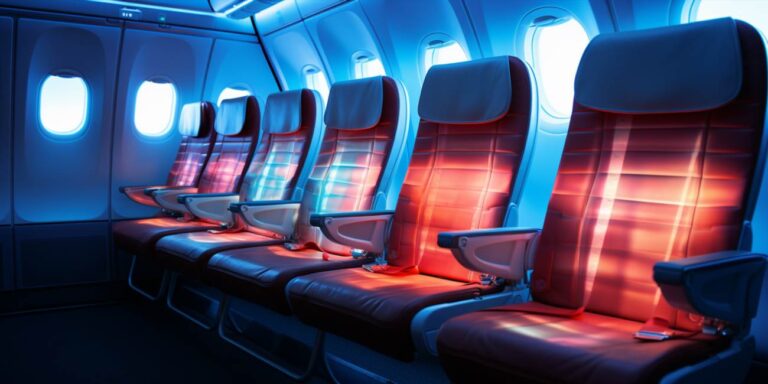Commercial airliners, the giants of the sky, come in different sizes, each with its own unique length. For instance, the Boeing 747, also known as the “Queen of the Skies,” boasts an impressive length of 231 feet. This iconic jumbo jet has been a symbol of long-haul air travel for decades.
On the other hand, the Airbus A380, the largest passenger aircraft in the world, surpasses even the Boeing 747 in length, measuring a staggering 239 feet. This behemoth of the skies has the capacity to carry hundreds of passengers across vast distances, making it a favorite among major airlines.
For medium-haul flights, the Boeing 737 is a common sight at airports worldwide. This workhorse of the aviation industry has a length of approximately 110 feet. Its versatility and fuel efficiency make it a popular choice for both short and medium-distance routes.
When it comes to regional jets, the Embraer E145 stands out with its compact size. This aircraft, often used for shorter flights, has a length of around 98 feet. Its smaller dimensions allow it to access airports with shorter runways, providing connectivity to smaller communities.
Now, let’s shift our focus to military aircraft. The F-22 Raptor, a cutting-edge fighter jet, has a length of 62 feet. This sleek and agile aircraft is designed for high-performance air superiority missions, showcasing the importance of size and maneuverability in military aviation.
Helicopters, a distinct category of aircraft, also vary in size. The Sikorsky CH-53K King Stallion, a heavy-lift cargo helicopter used by the U.S. Marine Corps, has a length of 99 feet. This powerful helicopter plays a crucial role in transporting heavy loads in challenging environments.
Airliner wing dimensions and size
When delving into the realm of aviation engineering, the dimensions and size of an airliner wing become crucial elements that define the aircraft’s performance and capabilities. These expansive structures play a pivotal role in ensuring the aircraft’s stability, lift, and overall aerodynamic efficiency.
Typically, an airliner wing exhibits a span that extends from one wingtip to the other. This span is a critical determinant of the aircraft’s ability to generate lift, with longer spans generally contributing to enhanced lift and improved fuel efficiency. Engineers meticulously calculate the optimal span based on the specific requirements and design considerations of each aircraft model.
Another vital dimension to consider is the chord length of the wing, representing the distance between the leading and trailing edges. The chord length significantly influences the wing’s aerodynamic characteristics, affecting lift, drag, and maneuverability. A larger chord may provide more lift but can also increase drag, leading to a careful balance in the design process.
Engineers also pay close attention to the wing aspect ratio, which is the ratio of the span to the average chord. This parameter influences the distribution of lift and drag across the wing. High aspect ratios often result in lower induced drag and improved fuel efficiency, while lower aspect ratios may enhance maneuverability.
Furthermore, the sweep angle of an airliner wing is a critical factor affecting the aircraft’s performance at different speeds. The sweep angle refers to the angle between the wing’s quarter-chord line and the aircraft centerline. Wings with a swept-back configuration are common in high-speed aircraft, reducing drag and enhancing stability.
For a comprehensive understanding of airliner wing dimensions, it’s essential to delve into the realm of wing loading. This parameter involves the distribution of the aircraft’s weight across the wing’s surface area. A higher wing loading may result in a more substantial lift force, contributing to improved performance during takeoff and climb.
Airliner cabin and cargo hold length
When it comes to the design of commercial airliners, the cabin and cargo hold play crucial roles, each with its own unique features and specifications. Let’s delve into the internal volume of these sections, uncovering the intricacies that contribute to the overall functionality of an aircraft.
Starting with the cabin, it serves as the primary space for passengers during their journey. Airlines meticulously plan the cabin layout to optimize seating capacity while ensuring passenger comfort. The internal volume of the cabin is a delicate balance between providing ample room for travelers and maximizing the overall efficiency of the aircraft.
Considerations for the cabin extend beyond just passenger seating. The placement of lavatories, galleys, and crew rest areas further influences the internal volume distribution. Aircraft manufacturers employ innovative design strategies, often incorporating curved walls and strategic seat arrangements to make the most of the limited internal volume within the cabin.
Now, shifting our focus to the cargo hold, it is a critical component responsible for transporting goods and baggage. Unlike the cabin, the cargo hold is designed to accommodate various shapes and sizes of cargo. The internal volume of the cargo hold is optimized for efficient storage and retrieval of cargo items, with features such as specialized containers and secure tie-down points.
The cargo hold is often divided into compartments, allowing for the segregation of different types of cargo. Airlines and logistics companies meticulously plan the utilization of the internal volume within the cargo hold, considering factors such as weight distribution and the nature of the cargo being transported. This ensures the safety and stability of the aircraft during flight.
When examining the overall design of an aircraft, the cabin and cargo hold work in tandem to balance the internal volume for both passengers and cargo. This delicate equilibrium is a testament to the engineering precision required in the aviation industry. The interaction between the cabin and cargo hold internal volumes showcases the complexity of designing aircraft that meet the diverse needs of modern air travel.
Passenger airplane length compared to jumbo jet
When it comes to the world of aviation, the size and dimensions of passenger airplanes play a crucial role in defining their capabilities and functions. The comparison between the lengths of different aircraft, especially the iconic giants like Boeing and Airbus, often captures the fascination of aviation enthusiasts.
Let’s start with a glance at the jumbo jets, the colossal beasts of the sky that have redefined long-haul travel. The term ‘jumbo jet’ is commonly associated with the Boeing 747, which revolutionized air travel with its distinctive hump and colossal size. The length of a typical Boeing 747-8, the latest iteration of this aviation marvel, spans approximately 76.3 meters. This length not only showcases the engineering prowess of Boeing but also highlights the spacious interiors capable of accommodating hundreds of passengers.
Turning our attention to Airbus, the European aviation giant boasts its own contender in the jumbo category – the Airbus A380. In a head-to-head comparison of lengths, the Airbus A380 outstretches the Boeing 747-8, measuring a staggering 72.7 meters. Despite being slightly shorter than its Boeing counterpart, the Airbus A380 compensates with its wider cabin, providing a luxurious and comfortable experience for passengers.
While the jumbo jets showcase the epitome of size in commercial aviation, it’s essential to explore the more standard models as well. The Boeing 737, a workhorse of the skies, features a length that ranges from approximately 28.6 to 44.5 meters, depending on the specific variant. On the Boeing side of this comparison, the 737 represents a versatile and widely used aircraft, catering to various airline needs with its range of sizes.
On the Airbus front, the A320 family stands as a counterpart to the Boeing 737. With a length ranging from around 31 to 38.7 meters, the Airbus A320 series competes fiercely in the narrow-body segment, offering efficiency and reliability to airlines globally. This comparison highlights the ongoing rivalry between Boeing and Airbus as they strive to dominate different market segments.
Summing up this exploration of Boeing, Airbus, and the jumbo jet realm, it’s evident that each aircraft’s length is a key factor in defining its role in the aviation landscape. The comparison between these giants not only emphasizes their engineering achievements but also reflects the diverse needs of the airline industry, from the spaciousness of jumbo jets to the efficiency of narrow-body workhorses.
See also:
- Airbus a380 vs boeing 787 – which passenger plane is better?
- What is a c17 aircraft: heavy military logistical transport capabilities
- Fuel efficiency revolution: what is the most fuel-efficient commercial aircraft
- Embraer 175 – hand luggage dimensions
- Embraer 170 versus boeing 737 – which passenger plane is better?





